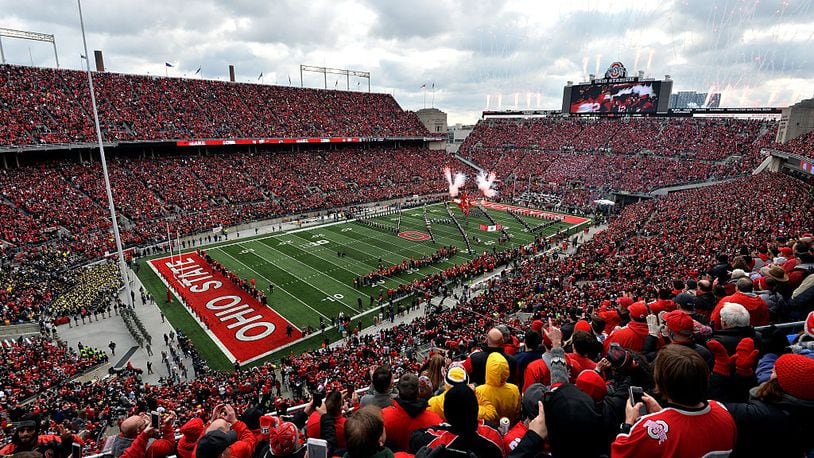Here are six things to know about that team:
1. The squad had numerous connections to the Miami Valley.
That begins of course with coach Woody Hayes, who was born in Clifton on Valentine's Day in 1913.
His 18th Ohio State football team had nine players from local high schools: Doug Adams (Xenia), Thomas Bartley (Springfield South), Leo Hayden (Roosevelt), Robert “Butch” Smith (Hamilton Catholic), Larry Qualls (Belmont), Bill Long (Stebbins), Bill Pollitt (Belmont), Gary Roush (Springfield South) and Jaren “Jay” Bombach (Fairview).
The media guide called Adams, a starting linebacker, the hardest hitter on the freshman team in ‘67.
Hayden, who finished his career with 1,395 yards rushing, saw regular time at halfback as a sophomore.
The coach of the freshman team was Glenn “Tiger” Ellison, the long-time coach at Middletown High School who is credited with inventing the run-and-shoot offense.
2. The ’68 team benefitted from an infusion of fresh talent and new tactics.
Quarterback Rex Kern and defensive back Jack Tatum headlined a group of second-year players who would go on to be known as the “Super Sophomores.”
They benefited from some open-mindedness from their famously stubborn head coach.
The Buckeyes had heads spinning across the Big Ten with a new hurry-up offense that averaged 84 plays per game, and new offensive coordinator George Chaump convinced Hayes to install the I formation.
That allowed Kern and company to stretch the field wide more easily than was allowed in Hayes’ beloved T, which remained the go-to formation in short-yardage situations.
Ohio State looking at ways to improve short-yardage offense https://t.co/cDELrORhrl
— Marcus Hartman (@marcushartman) October 11, 2018
3. Long had been the starting quarterback in 1966 and ‘67 but was replaced by Kern in ’68.
Long, a member of the Stebbins High School Athletics Hall of Fame, wrote in Columbus Magazine last year he never knew why he lost his job after leading the Buckeyes to four straight wins to conclude the '67 campaign, though skipping spring football practice in '68 to play baseball may have had something to do with it.
Hayes presented Long with a game ball from the Rose Bowl victory, but that did not quell his disappointment in his role in his senior season.
"Even as the years passed, I was never brave enough to broach the subject of the '68 season with Woody," Long wrote last year. "He went to the grave before I could question him about my demotion: Was Kern really a better quarterback than me? Was Woody giving Kern some playing time to groom him for a later championship run, a more logical expectation, but the Super Sophomores came through a year early? And why couldn't Woody talk to me about what happened? Didn't he owe it to me? After all, the old man might never have won the national title in '68 if I hadn't helped save his job the year before. Nearly 50 years since my season on the brink, I still find myself thinking about Woody. He was in my head then, and he's still there today."
.@OhioStFootball: Wayne grad Robert Landers finding ways to contribute on and off the field @marcushartman https://t.co/padvL0HKgS pic.twitter.com/U5XjvC0TMj
— Dayton Daily News (@daytondailynews) October 11, 2018
4. The Game was no contest.
Ohio State’s undefeated regular season culminated with one of the Buckeyes’ most lopsided defeats of Michigan.
Leading 21-14 at halftime, Ohio State blew the Wolverines’ doors off in the second, outscoring them 29-0 with the offense in full bloom.
"This Buckeye team is unlike any of the other memorable ones, and not just because it throws passes, uses reverses and revels in fakery — things that Woody Hayes used to think belonged in basketball," Dan Jenkins wrote in Sports Illustrated, "What it brings to the football field is a maniacal enthusiasm that only youth can have, combined with a confidence that stems from the optimism of immaturity than from the experience of age."
This weekend the 1968 @OhioStateFB team is having a reunion. They once inspired @danjenkinsgd to write this, the greatest lede of all time @sivault https://t.co/eEBi1AqtvA pic.twitter.com/gTsRn7acRx
— Marcus Hartman (@marcushartman) October 11, 2018
The Buckeyes ran for 421 yards and forced four turnovers.
Adams had eight tackles, an interception and forced a fumble.
5. The Buckeyes put the finishing touches on their masterpiece season by rallying to beat USC in the Rose Bowl.
O.J. Simpson gave the second-ranked Trojans a 10-0 lead with an 80-yard touchdown run in the second quarter and finished with 171 yards, but Ohio State scored the next 27 points to take control of the contest.
Hayden ran fo 90 yards and caught a 4-yard touchdown pass for the Buckeyes, who eventually won 22 games in a row.
6. The 1968 season was not only memorable in its own right, it kicked off a second historic run for Hayes.
The Buckeyes won four Big Ten titles and three national championships under Hayes from 1954-61, but Ohio State suffered in the aftermath of the school’s faculty council denying the Buckeyes a trip to the 1961 Rose Bowl.
That hurt recruiting in the Midwest, leading Hayes to widen his recruiting base -- a move that would pay off supremely.
That brought him such future stars as Jack Tatum (Passic, N.J.), John Brockington (Brooklyn, N.Y.), Bruce Jankowski (Fair Lawn, N.J.) and Jan White (Harrisbug, Pa.) in the ’67 class alone.
From ’68-77, Ohio State won or shared the Big Ten championship nine times. The Buckeyes played in seven Rose Bowls and were also named national champions in 1970.
About the Author
